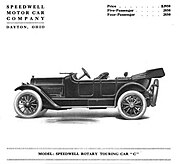Speedwell Motor Car Company
 Speedwell radiator emblem | |
 1911 Speedwell Motor Car Company catalog cover | |
| Industry | Automotive |
|---|---|
| Founded | 1907 |
| Founder | Pierce Schenck |
| Defunct | 1915 |
| Fate | Bankruptcy |
| Headquarters | Dayton, Ohio, |
Key people | Pierce D. Schenck, Gilbert J. Loomis, Cyrus E. Mead |
| Products | Automobiles |
Production output | 4,000 est. (1907-1914) |

The Speedwell Motor Car Company was a Brass Era American automobile manufacturing company established by Pierce Davies Schenck that produced cars from 1907 to 1914. The Great Dayton Flood of 1913 greatly damaged the Speedwell factory and inventory, and the company entered receivership in 1915 after having built an estimated 4,000 cars and trucks.[1][2]
History
[edit]Pierce D. Schenck of Dayton established the Speedwell Motor Car Company with a $50,000 capitalization. He hired Gilbert J. Loomis, who had built Loomis cars in Massachusetts, as Chief engineer.[2][1]
The first Speedwells had Rutenber four and six-cylinder engines on wheelbases of 116 and 132 inches. After the Panic of 1907, the decision was made to build cars on one chassis of 120 inches with a four-cylinder engine built by Speedwell. By 1909 model year production quadrupled from the 25 cars produced in 1907.[3][1]
Schenck expanded his factory until there were nine buildings.[1] The company rented factory space to the Wright Company to build its airplanes from February to November 1910, while the Wright Company built its own factory building in west Dayton.[4]
From 1909, the Speedwell's base price was $2,500, equivalent to $81,750 in 2023. Advertising stated "It would be folly to pay more," and “It would be unwise to pay less."[5][6] The Speedwell was a well built car with a dedication to detail. Speedwell was among the earliest companies to market a torpedo and the only one to use concealed door hinges and place the horn under the hood. Although a one-chassis policy, it did not limit Speedwells being offered in several body styles, including some evocatively called Cruiser, Duck Boat and Speed Car.[5][7]
From 1910, Speedwell was manufacturing light and heavy duty delivery trucks as well. Most of the 4,000 Speedwells built during the lifetime of the company were sold from 1909 to mid-1912. In 1911, Speedwell built a closed two-door, dubbed a sedan, which was the first recorded use of the term.[8] Pierce Schenck turned his interest to malleable iron, and soon after, Gilbert Loomis left Dayton.[1]
Cyrus E. Mead designed a rotary-valve engine and supporters bought into Speedwell Motor Car Company to get it into production. The Mead people pushed through a rotary-valve car, while the Speedwell people insisted that a standard poppet-valve car be offered as well, resulting in both types being offered.[9][10] In 1913, Cyrus Mead was killed in an automobile accident, which meant that any refinements needed to the engine would no receive the expertise of its inventor.[11][2][1]
In March 1913, the Great Dayton Flood put the Speedwell plant out of action for several months. The dealer agencies for Speedwell was initially very strong, but dealers left in large numbers when their deliveries slowed down. The rotary-valve six-cylinder model was also not selling well. Bankruptcy was declared early in 1915.[1][2]
The Speedwell factory was leased to the Recording and Computing Machines Company and was later sold to the W. M. Pattison Supply Company. The repair parts and business of Speedwell was acquired by the Puritan Machine Company, headed by A. O. Dunk who made a practice of buying failed automobile companies.[1] The factory site later hosted a Delco factory. The Speedwell factory buildings are not extant. About 12 Speedwells are known to be extant.[12]
- Models and Advertisements
-
1909 Speedwell advertisement
-
1910 Speedwell 50 Special advertisement
-
1911 Speedwell advertisement
-
1911 Speedwell Model H - F - Special
-
1911 Speedwell Torpedo
-
1912 Speedwell Speed Car advertisement
-
1913 Speedwell Rotary Six advertisement
-
1914 Speedwell Rotary Model C
-
1914 Speedwell Rotary Six
See also
[edit]- Apple, an early Dayton automobile manufacturer
- Dayton Electric, an early Dayton automobile manufacturer
- Stoddard-Dayton an early Dayton automobile manufacturer
References
[edit]- ^ a b c d e f g h Kimes, Beverly Rae; Clark Jr., Henry Austin (1996). Standard Catalog of American Cars 1805-1942 (3rd ed.). Krause Publications. ISBN 978-0-87341-428-9.
- ^ a b c d Georgano, Nick (2001). The Beaulieu Encyclopedia of the Automobile (3 vol. ed.). Fitzroy Dearborn Publishers. ISBN 1-57958-293-1.
- ^ Cycle and Automobile Trade Journal. Chilton Company. 1909.
- ^ Johnson, Mary Ann; maps by Frank Pauer (1996). Field Guide to Flight: On the Aviation Trail in Dayton Ohio (Rev. ed.). Dayton, Ohio: Landfall Press. ISBN 0-913428-58-2.
- ^ a b The Automobile, Automotive Industries. Chilton Company, Incorporated. 1911.
- ^ The Horseless Age: The Automobile Trade Magazine. Horseless Age Company. 1909.
- ^ Automobile Trade Journal and Motor Age. Chilton Company. 1912.
- ^ G.N. Georgano Cars: Early and Vintage, 1886-1930. (London: Grange-Universal, 1985)
- ^ Automobile Journal. 1912.
- ^ Automobile Topics. E.E. Schwarzkopf. 1913.
- ^ Motor World Wholesale. Chilton Company. 1913.
- ^ "1911 Speedwell Series 11 50HP". conceptcarz.com. Retrieved 2022-11-16.
Additional reading
[edit]- Curt Dalton, Roger L. Miller, Michael M. Self, and Ben F. Thompson, Miami Valley's Marvelous Motor Cars: From the Apple-Eight to the Xenia Cyclecar, 1886-1960 (2007).
External links
[edit]- Defunct motor vehicle manufacturers of the United States
- Motor vehicle manufacturers based in Ohio
- Defunct companies based in Dayton, Ohio
- Vehicle manufacturing companies established in 1907
- Vehicle manufacturing companies disestablished in 1915
- 1900s cars
- 1910s cars
- Brass Era vehicles
- Cars introduced in 1907









